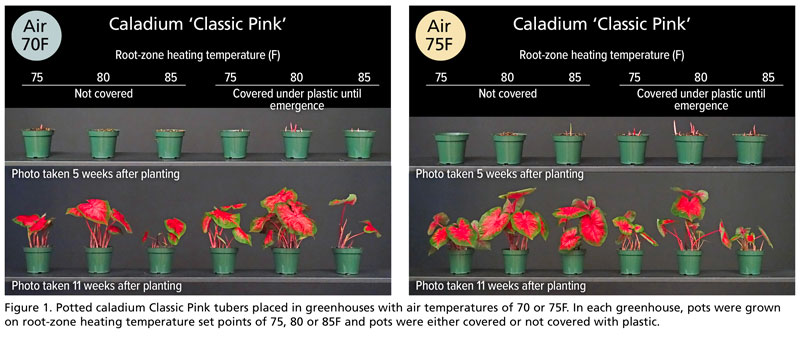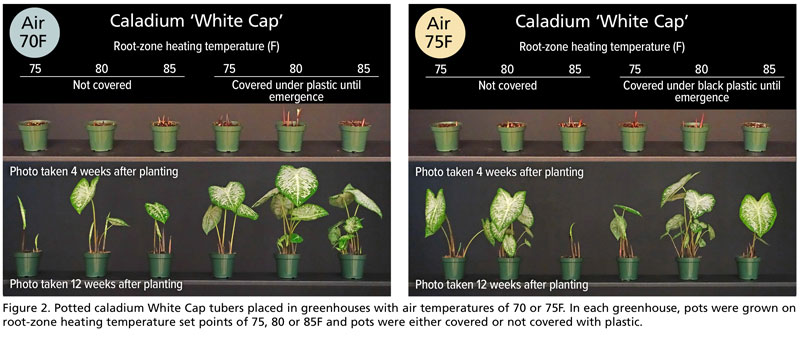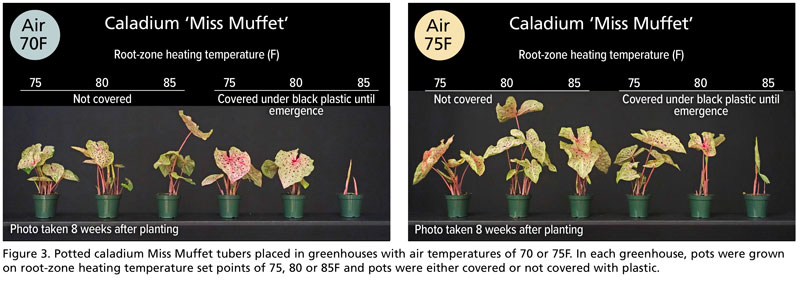10/1/2022
Avoiding Caladium Conundrums
Roberto Lopez, Caleb Spall & Nathan Durussel
Given that caladiums are native to tropical regions of Central and South America, they’re susceptible to chilling injury at temperatures below 64F (18C). Therefore, temperature during storage, shipping and forcing need to be closely monitored.
Symptoms of chilling injury can include soft or rubbery tubers and delayed leaf emergence, lack of crop uniformity in shoot emergence (sprouting) and leaf number, and inconsistent crop timing. Other chilling injury-induced physiological disorders include a change of foliage color to pink or green, known as “pinking” or “greening.” Additionally, excessively high air and substrate temperatures of 109F (43C) and above have been shown to inhibit caladium emergence and growth. Potted caladium tubers are typically placed pot-to-pot on benches or on the floor and covered with plastic until shoots begin to emerge. Although bottom heating is said to be beneficial, no temperature set points are recommended.
It's not uncommon for greenhouse growers, especially those in northern latitudes, to report delayed leaf emergence, lack of crop uniformity in emergence and leaf number, and inconsistent crop timing due to exposure to temperature extremes. This can negatively influence profitability for growers due to increased energy costs for delayed and non-uniform crops, and reduced sales, as the ornamental value of caladiums and their performance in the landscape is determined by foliage quantity and quality.
Therefore, the goal of our research was to determine the effects of air, substrate and irrigation water temperature on sprouting, growth and development, and to generate research-based protocols enabling greenhouse growers to optimize production of caladiums, consume less energy, and produce high-quality and uniform crops.
The study
No. 1 tubers of caladium (fancy and strap leaved) Classic Pink, Pink Splash, Bombshell, White Cap, Candyland, Rosemary, White Marble, Desert Sunset, Miss Muffet, Pink Beauty, Sweetheart and Tapestry were received from Classic Caladiums, and Bates Sons & Daughters Caladiums. The tubers were allowed to cure, de-eyed following industry protocols and planted in a 4.5-in. container filled with a peat and perlite-based substrate.
The potted tubers were then placed in one of two glass-glazed greenhouse sections under natural daylengths with an air average daily temperature (ADT) set point of 70 and 75F. Each greenhouse section had three benches equipped with closed-loop bench-top root-zone heating (RZH) that provided three RZH temperatures of 75, 80 and 85F.
To simulate current grower practices, half of the containers on each bench were covered with plastic and the other half were not covered. Upon emergence, each container was removed from under the plastic and placed on the same RZH bench. Plants were irrigated as needed with reverse osmosis (RO) water heated to 70F and fertigated with RO water supplemented with 13N–3P–15K water-soluble fertilizer providing (in ppm) 125 nitrogen, 12 phosphorus, 100 potassium, 65 Ca, 12 Mg, 1.0 iron and copper, 0.5 manganese and zinc, 0.3 boron, and 0.1 molybdenum.
Once 50% of the plants of one cultivar and treatment had emerged, they were transferred to one of two greenhouse compartments with day and night (12 h/12h) air temperature set points of 70/60F (65F ADT) and 75/65F (70F ADT) for finishing.
Our findings
Generally, sprouting and leaf unfolding were delayed or inhibited at an air and RZH set point of 70 and 75F (not covered with plastic) and 75 and 85F (covered with plastic), respectively (Figures 1, 2 and 3). At an air temperature set point of 70 or 75F, sprouting, leaf unfolding and finish plant quality of most cultivars were generally best at a RZH set point of 80F with or without plastic.
For example, when plastic was placed over potted Classic Pink tubers, time to emergence at RZH temperatures of 75, 80 and 85F was 24, 23 and 32 days (Figure 1). While time to emergence for tubers that were not covered with plastic and placed at RZH temperatures of 75, 80 and 85F was 31, 27 or 39 days.
Similarly, air and substrate temperature and covering influenced the height of shoots after 11 weeks (Figures 1, 2 and 3). For example, the height of Classic Pink shoots was 5.5 in. greater when the tubers were placed in a greenhouse with an air temperature of 75F, substrate temperature of 80F and covered with plastic compared to those that were in a greenhouse with an air temperature of 70F, substrate temperature of 75F and not covered with plastic.
For Classic Pink, White Cap and most other cultivars, the number of shoots that emerged was not influenced by air or substrate temperature or covering (Figure 1 and 2). Candyland was the most tolerant of extreme temperatures.
In the next article, we’ll look at how water temperature influences emergence and other quality parameters. Additionally, we’ll look at how finishing temperatures can be used as a plant growth regulator.
General recommendations for forcing of strap-leaf, fancy and dwarf caladium cultivars:
Sprouting/Emergence
If you’re covering pots with plastic until emergence:
• Maintain air temperatures between 70 to 75F
• Avoid root-zone heating temperatures >80F
• Substrate temperatures can exceed 100F with a RZH set point of 85F and plastic
If you are NOT covering pots with plastic:
• Maintain your air temperature at 75F
• Maintain your root-zone heating set point between 80 to 85F
Acknowledgements: We thank J.R. Peters for fertilizer, Classic Caladium’s and Bates Sons & Daughter’s Caladiums for tubers, East Jordan Plastics for pots, Kalamazoo Specialty Plants for shipping, The Fred C. Gloeckner Foundation, the Western Michigan Greenhouse Association, and the Metro Detroit Flower Growers Association for funding. GT
Roberto Lopez is an Associate Professor and Controlled Environment/Floriculture Extension Specialist, Nathan Durussel is a greenhouse technician and Caleb Spall is a former M.S. student in the Department of Horticulture at Michigan State University.


